Progress on research and mitigation of wind-blown sand risk in Dunhuang Singing Sand Mountain and Crescent Spring Scenic area,China
BenLi Liu ,KeCun Zhng ,JinJun Qu,b ,HiJing Li ,QingHe Niu ,ZhiShn An ,YingJun Png,LiHi Tn,GenSheng Yng,1
a Laboratory of Ecological Safety and Sustainable Development in Arid Lands/Research Station of Gobi Desert Ecology and Environment in Dunhuang,Northwest Institute of Eco-Environment and Resources,Chinese Academy of Sciences,Lanzhou,Gansu 730000,China
b Southern Marine Science and Engineering Guangdong Laboratory (Guangzhou),Guangzhou,Guangdong 51145,China
c Administrative Office of the Dunhuang Singing Sand Mountain and Crescent Spring National Scenic Spot,Dunhuang,Gansu 736200,China
d Institute of Desertification Studies,Chinese Academy of Forestry,Beijing 100091,China
Keywords: Singing Sand Mountain Crescent Spring Wind-blown sand problem Wind flow field Star dune
ABSTRACT The Singing Sand Mountain and Crescent Spring Scenic Spot in Dunhuang,Northwest China is a world-renowned desert attraction that is also an integral component of the Dunhuang UNESCO Global Geopark.This scenic area underwent a 30-year transformation,i.e.,from a severe sand risk with spring water threatened by sand burial due to dune deformation,to restoration of the original sand flow field and mitigation of the sand burial problem.The current paper summarizes the research on the intensive monitoring of the dynamic change of star dunes near the spring,observation of wind and sand flow movement,and then restoring the harmonic vibration of the sand particles(singing sand)that were previously silenced.The existing and prospective impacts of anthropogenic and natural forces on the deformation of the sand dunes are investigated by integrated methods,guiding the implementation of mitigating measures with significant ameliorative effects.Contrast to common sand control practices that aim to reduce wind speed and stop blown sands,our research highlights the importance of maintaining the natural wind flow field in stabilizing surrounding dunes.These mitigation measures consist of removing excessive vegetation and newly constructed buildings to recover the original wind flow field and sand transport activity.Such research and mitigation efforts ensure the scientific protection and restoration of the special desert landform,and contribute to the mutual enhancement of the conservation and exploitation of this desert scenic spot and similar sites.
1.Introduction
The Crescent Spring Scenic Spot is located at the western end of the Hexi Corridor and the center of the ancient Silk Road in Dunhuang City,Gansu Province,China.It is one of the most well-known desert landscapes in arid Northwest China(Dong and Bian,2004),attracting up to three million tourists per year.The spring is situated at the edge of the Dunhuang Oasis and Mingsha Megadune (which means "Singing Sand Mountain"in Chinese),which is encircled by giant star dunes(or pyramid dune) that are all higher than 100 m (Fig.1a).According to ancient historical documents,the dunes and the spring have coexisted for at least two millennia(Zhang et al.,2004),but in recent decades,the wind-blown sand movement impacted by human activity poses a threat to this precious scenic spot as the dunes to the north and south tend to migrate toward each other,resulting in shrinkage of the spring area and future burial (Zhang et al.,2015).These threats posed by wind-blown sand,which may lead to the disappearance of the spring,have attracted widespread attention (Zhang et al.,2019).Targeted interventions were prescribed to alleviate these problems and preserve the spring,but it is necessary to investigate the causes of the hazards beforehand.
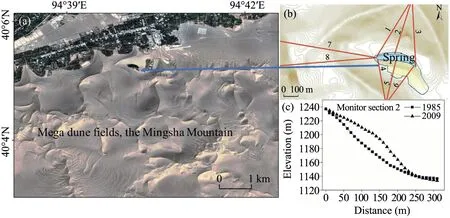
Fig.1. (a)Location,(b)remote sensing monitoring sections(red lines from the top of the south and north dunes to the spring),(c)and height change of representative section at different years in the middle of the north star dune of Crescent Spring.The increase of elevation in 2009 compared to that of 1985 indicates dune shape change approaching the spring.Data from Zhang et al.(2013).
Since 2008,aeolian researchers and management departments have collaborated to establish multiple observation sites and to study regional air circulation,local airflow characteristics,blown sand activities,as well as sand dune morphologies and their changes using a variety of scientific techniques,such as in-situ measurements,wind tunnel test,and computational numerical simulation.The scientific causes of the hazards posed by wind-blown sand were identified,as well as strategies for their mitigation.Then,engineering control measures were implemented,which effectively mitigated the threat posed by the blown-sand problems to the spring.These works are acknowledged by all sectors of society.Compared to most sand control works that aim to reduce wind speed and fix surface sand by implementing biological and engineering measures,the mitigation of the blown sand risk for Crescent Spring focuses on the restoration of natural wind flow and the elimination of increased wind obstacles,which makes the protection work unique and attractive.
This paper reviews the research and mitigation efforts related to the control of wind-blown sand problems and the restoration of the natural wind flow field at Crescent Spring over the past 15 years.In addition,the presence of the typical three-sided star dune to the north of the spring has raised the interest of researchers in the formation and evolution mechanism of star dunes,as well as the interaction between sand dune and water body.Studies conducted on this representative dune have served as a benchmark in the field of aeolian geomorphology.This paper also summarizes the research progress of star dunes that based on these works.
2.Research on dune morphology
2.1.Long-term monitoring of morphology changes in adjacent dunes
The most prominent blown sand problem of Crescent Spring is from the adjacent star dunes that had a tendency to bury the spring,specifically the southward movement of the north dune and the northward movement of the south dune,which constrained the area of the spring.Using photographs from a century ago and interviews with local staff and residents,it has been demonstrated that the geometry of the north and south sand dunes has clearly changed and that they tend to be moving closer together and burying the spring.This threat merits an immediate solution.
The dynamic monitoring of worldwide star dunes is limited due to their long formation history,which may be longer than any observation period.Multiple monitoring sections were constructed using multiperiod remote sensing images from 1963,1985,2004,and 2009 for dynamic monitoring analysis (Fig.1b).It was discovered that slopes of the two dunes to the north and south,which are both over 100 m in height,were relatively stable,whereas slopes facing the spring had significantly increased in height and their ridge lines have moved together over the past several decades.The formerly smooth south face of the north dune rose more than 20 m in height,resulting in an evident bump toward the spring(Fig.1c),while the north face of the south dune rose approximately 15 m (Zhang et al.,2013;Pang et al.,2014).However,the west side of the north dune experienced a serious erosion of 24 m in depth (Zhang et al.,2019).As a result,evidence of dune morphology change is clear,as the two dunes converge and threaten the existence of Crescent Spring.Grain size analysis of surface sediments over the dunes provides further evidence for the varying erosion and accumulation conditions at various dune positions (Zhang et al.,2014;Pang et al.,2017).To mitigate this risk,the morphology of the dunes must be restored.
2.2.Short-period monitoring of dune morphology dynamics
In addition to long-term remote sensing monitoring,morphological changes of dunes that respond instantly to wind activities with higher temporal resolution are increasingly required to study the causes and predict the trend of dune movement.Large star dunes are generally quite stable,but their ridge lines undergo large dynamic changes in short time scales,which can swing more than 1 m under the influence of a strong wind,as determined by monitoring results using an electronic tachometer(An et al.,2016)(Fig.2a).This variation spectrum is comparable to that of low dunes.
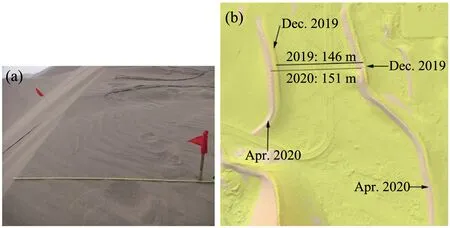
Fig.2. (a)Ridgeline oscillation of the south star dune after a gale,and(b)monthly ridge line changes of the northeastern linear dunes obtained by high-precision 3D laser scanning.
Significant advancements in three-dimensional (3D) laser scanning technology have been made in recent years(Hanke et al.,2015),allowing it to meet the time and space requirements in the study of dynamic changes of star dunes adjacent to Crescent Spring.Since 2014,annual 3D scanning of the dunes has been performed to create digital models,extract morphology changes,and calculate erosion and accumulation rates at various locations across the entire dune surface.Since 2019,monitoring frequency has been increased to 3-4 times per year in order to obtain dynamic change results within a year.It was proven that the ridge line of star dunes and the low-lying linear dunes in the perimeter underwent considerable change over the course of a year (Fig.2b),and impacts of the three principal wind directions on the seasonal morphological changes of dunes were investigated in depth (An et al.,2018;Zhang et al.,2019).During the observation period over the past few years,multiphase data indicate that the northward movement of the south dune has been limited,whereas the southerly surface bumping of the north dune has recovered in 2018-2019.
3.Research work on the wind flow field
3.1.Background winds
Previous wind tunnel experiments (Wang et al.,2010),numerical simulation (Liu et al.,2011;Zhang et al.,2012a),and observations (Qu et al.,1992) have conclusively demonstrated that star dunes are generated in a multi-wind environment.Since 2008,more than seven wind masts have been installed near Crescent Spring,and it has been determined that predominant wind directions at this spot are northeast,northwest,and south.At each site,characteristics of wind speed,wind direction,sand-driving wind,sand-drift potential(DP),and resultant drift potential(RDP)were analyzed(Fig.3)(Zhang et al.,2012b).Due to the presence of enormous dunes that act as wind obstacles,the direction and strength of the airflow near the spring are largely altered.Therefore,local circulation parameters around the scenic spot change greatly from the upwind wind field.At the same time,eight-point sand samplers were buried at each site to observe the actual sediment transport,and the observed value was found to be in general agreement with the estimated sediment transport(An et al.,2014).

Fig.3. Annual sand drift potential (DP) and resultant drift potential (RDP) at multiple observation points around Crescent Spring.Data based on (Zhang et al.,2012b).
Monitoring studies indicates that the dynamic equilibrium of sediment transport under the three principal wind directions is the primary reason for the long-term persistence of huge dunes and Crescent Spring.The northeast wind and northwest wind are mainly influenced by regional circulation (An et al.,2013),whereas the southerly wind is the valley wind caused by the complex terrain of sand mountains and the difference in heat capacity between the sand dune and the spring(Zhang et al.,2013,2015).The valley wind and regional system wind combine to produce a multi-directional wind environment,which provides the necessary material and energy for the growth and stability of star dunes(Qu et al.,1992).A nested Weather Research and Forecasting (WRF)model was used to distinguish the effects of regional large-scale circulation(northeast and northwest winds)from the dune-spring small-scale circulation (south wind),and it was discovered that the near-surface valley wind can cause wind speed changes of 2 m/s intensity with high frequency (Tian,2011).In addition,the south wind can reach the intensity of strong aeolian sand activities,so its impact on the local flow field,sand transport,and maintenance of dune morphology is significant(Zhang et al.,2019).
The observations of airflow and sand movement demonstrated that,due to the influence of newly constructed buildings and trees over the past years,the east wind that reaches the spring has decreased,and the original sand transport condition has become unbalanced (Zhang et al.,2012b).In contrast,the south wind was stable and relatively stronger than before,causing the northward migration of the south dune and burying the ancient buildings near the spring(Pang et al.,2015).
3.2.Surface airflow
Understanding surface airflow characteristics of the sand dune is very important for comprehending the sustained coexistence of the large dune with Crescent Spring.The complex near-surface flow field of a star dune results in a different dune movement pattern and growth compared to other dune shapes,such as transverse and longitudinal dunes.Typically,two-dimensional (2D) or sectional observation or testing is used to investigate the wind flow or sand movement of common dunes in symmetrical dunes (Parsons et al.,2004).However,3D characteristics of star dunes are significant,particularly the angle of airflow between sand ridges,the leeward side backflow after different faces (Wang et al.,2010),and changes in airflow under different wind directions(Liu et al.,2011).These lateral and vertical inhomogeneities of airflow cannot be discovered in 2D experiments or simulations (Liu et al.,2011).
Multiple locations on the surface of surrounding dunes were outfitted with 2D and 3D wind speed and direction observation devices to record both short-term and long-term surface airflow variations,as well as blown sand flux and transportation quantity(Fig.4)(Bian et al.,2016).Among them,the ultrasonic anemometer can measure the 3D velocity,azimuth angle,and height angle of airflow at each location.For a basic dune with a simple structure,the effect of the predominant wind flow is relatively clear and defined.However,it has been proven that the star dune on the north side of the spring generates a high vertical ascending airflow and a strong backflow area on the leeward side under northeast wind conditions,similar to a transverse dune.Under a northwest wind,the dune modifies the airflow similarly to a longitudinal dune,and the wind speed on the windward side increases significantly with dune height (Zhang et al.,2016a).The morphological changes of star dunes are controlled by the activities of wind and sand,indicating once again that the original air flow field in this area must be restored to recover the morphology of the sand mountain (Zhang et al.,2019).These are the most comprehensive observations of a wind-sand flow field in 3D over a star dune.
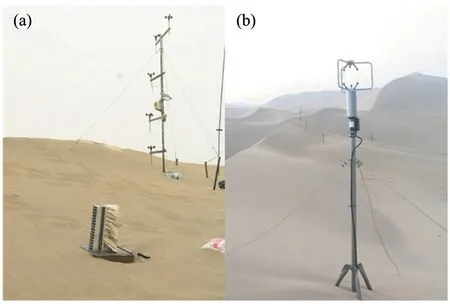
Fig.4. The 2D(a)and 3D(b)wind monitoring devices on the north dune beside the spring.
3.3.Relationship between wind flow and the growth of star dune
Star dunes have a complex shape and a lengthy formation process,which transcends the normal period of aeolian geomorphology observation.To date,there has been no direct observation of their formation and growth process,therefore,numerous hypotheses exist regarding their origins,such as deformation from crescent dune (Hu and Wu,1997),transverse dunes or merger of longitudinal dunes (Nielson and Kocurek,1987).Numerical simulation studies indicates that a high frequency of wind reorientation contributes to the high growth rate and low mobility of star dunes(Zhang et al.,2012a).
Observation and 3D numerical simulation of airflow over the complex dune surface proved the blocking effect of the surrounding terrain and dune shape on the uplift of airflow and the vertical growth of the dune.Different flow separations are caused by angles between the three inlet winds and the sand dune ridge lines,resulting in the extension of the desert arm (northwest and south winds) or the growth of sand height(northeast wind) (Tan et al.,2016;Zhang et al.,2016b).Based on these findings,the previously proposed three-stage model for the formation and evolution of star dunes was further refined(Qu et al.,1992),namely the longitudinal dune stage-embryonic star dune stage-stable and tall star dune stage(Fig.5)(Zhang et al.,2016a).The first stage may have an orientation of WSW-ENE,which is mostly influenced by the west and south winds,whereas the east side may have a tiny sliding surface due to the action of the northeast winds,and height of the dune is modest.When the dune grows and moves,especially after overcoming the underlying terrain obstacles,its body size may clearly increase and exceed the minimum size necessary to maintain stability of the star dune.At this stage,the vertical airflow begins to intensify,and a stable slope resembling a transverse dune form at the east of the dune under the influence of the east wind.Finally,as the dune continues to grow in height,its feedback effect on the airflow is amplified,and the intensity of the upward vertical airflow increases,resulting in a larger leeward backflow area and further ensuring the upward growth tendency of the dune.This model is confirmed by high-precision laser scanning results regarding the effect of multi-directional winds and the overall stability of the dune,despite local slope changes(An et al.,2022).

Fig.5. The three-stage growth model of a star dune:(a)longitudinal dune stage;(b)embryonic star dune stage;(c)stable and tall star dune stage.After Zhang et al.(2016a).
4.The influence of anthropological factors
4.1.Urban development in the upwind direction
At the beginning of the protection research project,Dunhuang City was preparing for a new round of district expansion.In the Gobi region to the northeast of Crescent Spring,a 24 km2administrative area was planned and slated for construction.Due to the large planning area's location in the path of the prevailing northeast wind and is proximity to the spring,it may disrupt the delicate wind circulation and compromise the dune-spring balance.Through field observation,detailed data analysis,and numerical simulations,we determined the impact of new city construction on the spring and the feasibility of the construction activity.
Wind observation control sites were established at the open Gobi area in the upwind(C1),the construction site(C2),and northeast of the spring(C3)(Fig.6a).On the construction site,five mobile wind masts were set up to create an observation section(O1-O5)(Figs.6b and 6c)in order to assess the effect of construction work on wind flows approaching the spring.Multiple observations of northeast wind events revealed that the newly constructed structures can reduce downwind speed by more than 40%(Fig.6d).However,the height of the buildings under construction at that time was lower than the downwind shelterbelt,and the construction area was smaller than intended,so the influence on the wind speed entering Crescent Spring was not significant,with less than a 5%reduction in reference wind speed.

Fig.6. Observation of the influence of urban development on the wind entering Crescent Spring:(a)fixed observation stations upwind,within,and downwind of the construction area;(b) intensive observation wind masts downwind of the construction area;(c) field photos of observation equipment;(d) changes of average wind speed at different sites during a northeast wind.
Then,numerical simulations based on the actual terrain of the entire proposed construction area and northeast Gobi was conducted to examine the variation of the airflow field under different future construction scenarios (Liu et al.,2014).Along the primary wind direction,two monitoring sections and eight scenarios with varying heights and areas of the new city were established.Compared to the scenario with the original landscape,it was determined that the current planning and design of the new city may reduce the northeast wind speed and wind energy reaching the spring by between 10% and 20%.To mitigate the possible impact,it is important to restrict the planning area by reducing the northwest boundary by 2 km and limiting building height to less than the existing wood height (12 m).By combining these two modification methods,the impact(reduction)of wind speed on Crescent Spring can be limited to within 1%-3%.This concept was well received by the local authority,and no new urban area was constructed along the wind path to the spring.These findings have immediate implications for regulating urban planning around (especially in the upwind direction of) the protected area and minimizing the alteration of wind field caused by new city development.
4.2.Surrounding vegetation
The area of woodland and orchard at the edge of Dunhuang Oasis to the north side of Crescent Spring has expanded consistently over the past 30 years,coinciding with the considerable change in dune morphology.Therefore,it is necessary to evaluate the influence of surrounding vegetation on the wind-sand flow field and morphology of star dunes.Due to the fact that the vegetation is relatively low compared to the 100-m-tall star dunes,the resolution of any modeling work must be high enough to accurately replicate its effect.We established high-precision scale wind tunnel experiments using a 3D-printed solid model in which the spatial position and percentage of surrounding ground items are all mirrored,and streamwise wind speeds were measured directly at the model surface by multiple pitot tubes (i.e.,Fig.9 of Liu et al.,2021).The impact of dunes,buildings,spring water,grassland,and trees are also simulated in meter-level numerical models in equal proportion(i.e.,Fig.8 of Liu et al.,2021).By varying the height or roughness of the surrounding vegetation,quantitative impacts of vegetation on changes in wind speed and direction at different locations exposed to northeast and northwest wind were determined.Under conditions of northwest wind,an increase in surrounding vegetation decreased wind speed by 9%-25% at the base of the windward slope and increased by 15%-30%at the summit of the dune ridge.As a result,the crest of the north star dune shifts southward and the spring area shrinks (Liu et al.,2021).These results provide direct evidence for restoring and stabilizing the sand dune morphology by rectifying the airflow field from restoring the natural vegetation types and reducing vegetation heights surrounding the scenic area.
4.3.The artificial removal of a dune arm
The shape of a tall sand dune is determined by the equilibrium between the aeolian sand landform and the wind condition.In the same way that dunes in different development stages have different forms of mutual feeding with wind field,if the shape of the sand dune is strongly disturbed by external factors,the wind field will also change,thereby altering the erosion and accumulation process as well as the shape of other portions of the dune.For the convenience of tourists,the southeast arm of the north star dune was removed artificially in the 1990s,which was also consistent with the later considerable morphological change of dunes.Therefore,it is necessary to access the impact of the artificial removal on the wind field surrounding the star dune.
The effect of the removal of the SE dune arm was studied using highprecision 3D wind tunnel tests and numerical simulations.With and without the arm,wind fields at various locations on the dune were compared.The dune arm was printed as a part of the solid model in the wind tunnel or visually constructed in the numerical simulation.Although the removed portion represented only 0.07% of the total volume of the dune(about 1×104m3),it had a significant impact on the extent and severity of the backflow zone on the south leeward area under northeast wind (Liu et al.,2021).Particularly,as a result of the decrease in wind speed and the change in wind direction on the southern slope,the local wind direction can be completely reversed(reduction in the size of the reverse bubble zone),which may be the direct cause of the accumulation of sediments in the middle of the southern slope and deformation of dunes as depicted in Fig.1c.Therefore,to maintain the morphological stability of the dune,reconstruction of the dune arm should be considered to preserve the dune's original wind flow field.
5.The acoustic mechanism and resounding of dumped singing sand
According to historical documents dating back more than twenty centuries,the Singing Sand Mountain derives its name from the evocative acoustic emission of its dunes (Lorenz and Zimbelman,2014).This is another reason why Crescent Spring is one of the most visited tourist destinations.However,the fact that this mystical natural phenomenon is rarely observed by the public in recent decades indicates that the sands have lost their ability to sing.
Multiple researchers investigated the mechanism of singing sands.At the microscopic scale,Bagnold (1966) attributed this to the size of the sand particle,whereas Goldsack et al.(1997)attributed it to the surface chemical layer.At the larger scale of sand groups,Andreotti (2004)believed that the cause is the synchronization of sound emission,while Douady et al.(2006) thought that the sound was generated from the shear of moving sands.
Studies were also conducted on the sand surface structure and echo mechanism of this earliest recorded singing sand dune.Sands from the dunes in Japan,Australia,Kuwait,Tengger Desert,the Singing sand in Dunhuang,and some beach sands were collected and compared using surface washing,chemical dissolution experiments,and scanning electron microscopy (SEM) analyses.Glass micro-balloons were used as control material.It was discovered that after washing,sand that was once silent became capable of booming,while clay residues are responsible for sound dampening.Intriguingly,glass micro-balloons can produce the same singing sound as sands following chemical denudation to form surface pits.These findings demonstrate that the acoustic function of singing sands is related to the porous(pit)physical structure of the sand surface,but has nothing to do with the chemical composition of the surface.Excessive dust impurities entering these holes will lead to the loss of the resonant mechanism of sand ringing (Qu et al.,1995,2022).Based on these studies,artificial resonance of the silent sand in the Singing Sand Mountain was realized.
Crescent Spring and Singing Sand Mountain are visited by a large number of people who trample and slide on the dunes,in addition to nearby industrial and mining industries,which contribute a lot of dust contaminants that can settle on the singing sands' surfaces.This could explain why the sands have been silent for the past decades.Therefore,to restore the acoustic function of the dunes,excessive tourist activities should be reduced,the environmental pollution from industries should be regulated,and the contamination of the surface of quartz sand grains should be eliminated.
6.The applied mitigation measures and their effects
6.1.Mitigation activities
In previous research,the wind field and dynamic change characteristics of sand dunes in the vicinity of Crescent Spring in the Singing Sand Mountain were recognized,as well as the causes of sand problems.Based on the aforementioned research,recommendations for short-,mediumand long-term sand control were proposed.Among them,the impact of tourists'tramping is visible,because a considerable quantity of sand has slid down the slopes of the two dunes confronting the spring,which exceeds the ability of the airflow to transport sands upward.Short-term solutions include restricting the climbing area and regulating the tourist population.For the influence of buildings and trees within and outside the scenic area,a series of measures are proposed to restore the original wind flow field,including opening the wind channel on the buildings,establishing a peripheral buffer zone,and removing buildings and trees upwind of the spring (medium term measure).In addition,regulatory recommendations for the size and height of buildings in the new urban area have been strictly implemented(long-term measure).Measures that focus on the restoration of spring water were also implemented by other authorities(Miao,2019).
In 2012,a series of mitigating measures were implemented.In the northeast direction,0.5 km2of a waste landfill site,mining and excavation of sand pits,and some unauthorized plant structures on the gravel surface were leveled(Fig.7a).In recent years,about 1,722 fruit trees and 10,047 wood trees on the edge of the oasis and at the north foot of the dunes were removed(Fig.7b).On the east side of the spring,the original administration office with 2,000 m2buildings has been relocated.The ancient building group adjacent to the spring has opened or walls demolished (Figs.7c and 7d) to minimize their influence on wind flow and restore the natural flow field.Currently,the preponderance of the work has been completed,except for the artificial restoration of the southeast arm of the north star dune,which was removed three decades ago.
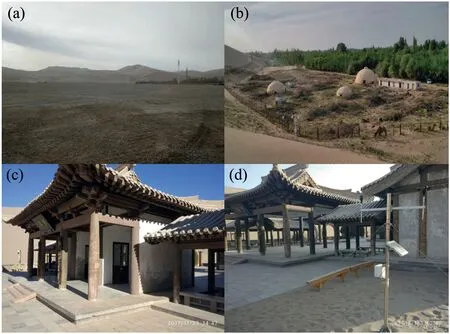
Fig.7. Applied mitigation practices to recover the wind flow field and sand dune form inside and outside the Crescent Spring Scenic Site.(a)Clearance of the Gobi in the northeast upwind direction;(b) Removal of excessive trees near the dunes;(c) before and (d) after the demolition of the ancient building wall near the spring.
6.2.Effect of mitigation measures
All mitigation measures have an immediate impact on restoring the original airfield and sand dune morphology surrounding the spring.Insitu observations indicate that the sand drift potential of the NW wind at the top of the north dune has roughly doubled since the implementation of the measures,and the average wind speed close to the spring has increased by more than 10% (Fig.8a).As a result,the bump"belly" on the south slope of the north dune tends to disappear,the accumulated 1.2-m-thick sand that once buried the corridor near the south wall of the ancient buildings was removed naturally by wind,and sand deposit on the east side of spring decreased significantly (Fig.8b).The monitoring results of 3D laser scanning indicate that the overall volume of sand dunes has increased in recent years and that their center of gravity has not shifted considerably,indicating a more stable condition(An et al.,2018).With the cooperation of other water restoration projects,the space of the spring between the dunes has been continuously restored,and the water area,which was drastically reduced to only 0.5 ha in the last century due to over-exploitation of ground water(Dong and Bian,2004;Li et al.,2020),has gradually increased to the current 1.6 ha (Fig.9).
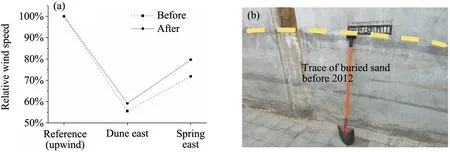
Fig.8. (a) Recovery of wind speed near the spring and (b) reduction of sand accumulation near the ancient building after the implementation of control measures.
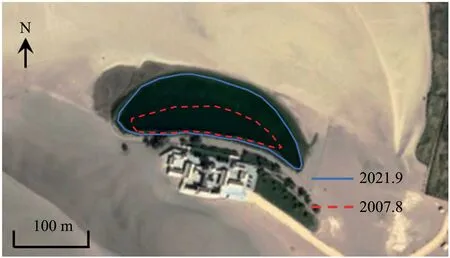
Fig.9. A comparison of water area of Crescent Spring in recent years.Base figure from Google Earth.
Furthermore,the enclosure,ecological improvement,and pollution control measures implemented at the scenic spot have purified the sand grains of the sand dunes and restored their natural singing function.In 2021,more than ten singing sand sites with potential tourism development value have been identified from a field investigation of singing sand resources.
7.Discussions
7.1.The impact of natural and anthropological factors on dunes
Traditionally,factors that can influence the morphology of sand dunes are sand source,wind environment,and terrain or vegetation obstacles.For instance,sand source determines the development of incipient dunes(Lü et al.,2021),the directional change of multiple winds can alter the shape of a star dune (Zhang et al.,2012a),and the surrounding terrain may facilitate the formation of star dunes by generating complex regional and secondary wind flow(Lancaster,1989;Zhang et al.,2016a).The majority of relevant publications focused on these natural factors,whereas the influence of human activities on star dunes are typically negligible and are rarely investigated.
However,the dunes surrounding Crescent Spring can be largely altered by anthropological variables,such as visitor trampling,the expansion of local vegetation and buildings,and the reclamation of desert land into orchards or cities.Research using remote sensing(Fig.1),topographic survey(Fig.2),wind and blowing sand monitoring(Figs.3,4 and 6),wind tunnel experiment,and numerical simulation all demonstrate that stability of the dunes is dependent on the balance of local three directional winds,while the modification of dune shape is very likely caused by human factors.The evident change in dune shape occurred simultaneously with intensification of anthropological disturbances,while its recovery occurred after the disturbances subsided(Fig.8).This mechanism is comparable to the contribution of human activities to global warming,which may severely accelerate the destructive process,but there is still a chance of reversal if the anthropological impacting factors(carbon emission)can be neutralized(Wang et al.,2021).
7.2.The recovery of dune shape and conservation of deserts
Deserts are natural landforms that must be considered as an integral element of the ecosystem,while desertification poses a risk to human wellbeing.In arid regions of China,large-scale ecological construction projects are undergoing at not only desertification lands,but also some natural deserts,and the reduction of desert area is a key indicator of the success of these projects.As a result,about 6,670 km2of deserts are converted to vegetated land annually,and 1.24×105km2of desert land will be vegetated by 2030 (National Forestry and Grassland Administration,2022).
Distinctively,the protection of Crescent Spring requires the preservation of the natural desert environment,and the removal of the increased manmade vegetation within and outside of the spot.The sand dune landscape and its coexistence with spring water can be appealing to a large number of tourists,and it is imperative that this desert area be investigated as a tourism resource.We suggest that natural deserts should be protected and conserved similarly to other landforms like forest and grassland,because the exploitation of desert tourist resources necessitates a minimum of anthropological disturbance,including avoiding excessive afforestation and windbreak works that may disrupt the original wind flow environment and the equilibrium of sand flow movement.
8.Conclusions
Crescent Spring is a rare natural desert scene,but disturbances on the wind flow field,including increased buildings,vegetation,and tourist trampling,have led to the deformation of surrounding dunes,the loss of spring space,and the silence of singing sands.The research on aeolian geomorphology has advanced over the past decade as a result of mitigation efforts based on extensive research on the star dune shape dynamic,wind flow,and their impacting elements.The improvements of these works include:
(1) High-resolution dynamic change monitoring was conducted on large star dunes to understand the status and process of the movement and deformation of the dunes that threatened Crescent Spring,as well as detailed morphology difference of erosion and accumulation at different parts of the dunes.
(2) The relationship between the large dune and the desert lake was investigated,and the contribution of the local air flow field on the morphological transformation of sand dunes was clarified.The valley wind caused by the complex topography of the sand dune and the difference in heat capacity between the dune and spring had a significant influence on the preservation of the unique morphology of Crescent Spring.
(3) The effects of man-made disturbances such as vegetation and buildings on wind speed reduction,airflow direction variation,dune crest line shift,and slope deformation,were evaluated,providing a basis for restoring the original natural wind flow field and dune morphology.
(4) Research on the development process of star dune is improved,and a three-stage development model is proposed.The influence of topography,wind direction,and other factors on each stage of the formation process of the three(or more for other dunes)dune face and dune arm are highlighted.
(5) The mechanism of singing sand has been explored,and the artificial restoration of singing sands has been successfully practiced.
(6) Restoration measures of the wind and sand flow field,such as removing newly added buildings and excessive vegetation,modifying the original building structure,and establishing enclosure areas,have produced noticeable results,restored the shape of surrounding sand dunes,and enlarged the water area of Crescent Spring.
The wind-blown sand risk mitigation measures protect and restore the unique desert landscape and scenic site.In contrast to other conventional sand control measures,such as vegetation planting or sand blocking,the practices here preserve the original wind and sand movement.These research-based practices demonstrate the importance of scientific research work to the resolution of practical problems.Consequently,ecological,social,and economic benefits were realized simultaneously.These research and practice activities also support the upgrading of the Crescent Spring Scenic area and Singing Sand Mountain to the highest level of national tourist attraction(5A)in 2015,as well as the world geopark-the Dunhuang World Geopark of China.
Acknowledgments
This work was supported by the National Key R&D Program of China(2018YFD1100104),the National Science Foundation of China(42071014),and the Youth Innovation Promotion Association of the Chinese Academy of Sciences(Y202085).
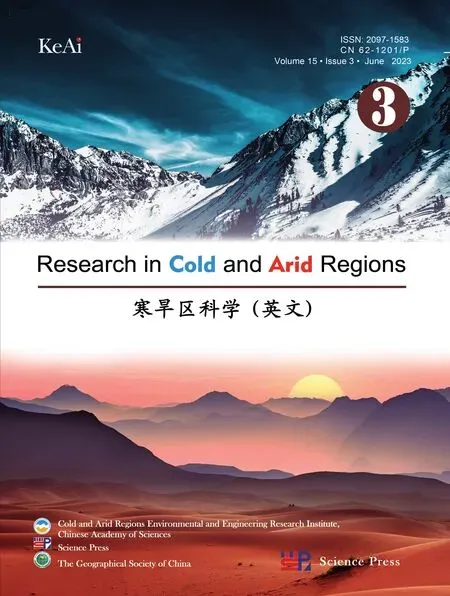 Sciences in Cold and Arid Regions2023年3期
Sciences in Cold and Arid Regions2023年3期
- Sciences in Cold and Arid Regions的其它文章
- Impacts of canopy structure on the sub-canopy solar radiation under a deciduous forest based on fisheye photographs
- Influence of climate change on hydrological process in the upper reaches of Shiyang River: A case study of the Xiying River,China
- Seepage influence of supra-permafrost groundwater on thermal field of embankment on Qinghai-Tibet Plateau,China
- An overview of the policies and models of integrated development for solar and wind power generation in China
- Editor-in-Chief Yuanming Lai
- Guidelines to Authors
